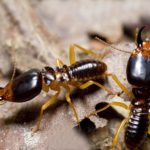
Have you ever wondered if our urban areas produce bigger bugs? Well, we now know the answer is, ‘Yes!’
While some bugs don’t do well around our homes and other buildings, other species thrive in this environment. The size of the pest is one good indicator of whether it is an ‘urban exploiter’ or not. If the pest is bigger in urban environments, it shows that being around humans and our structures greatly benefits it.
A recent study of a common pest in Australia, the golden orb-weaving spider, Nephila plumipes, showed that these spiders grow larger as the amount of urbanization increases. (Increases in urbanization was measured by increases in hard surfaces in an area, and decreases in leaf litter.)
Not only did they find spiders in urban areas were larger, but the weight of the spider’s ovaries also increased. Bigger ovaries means that these spiders produce more and healthier eggs in urban environments.
Scientists do not completely understand why some bugs become ‘urban exploiters’ while others do not. But sometimes certain areas around homes and buildings are warmer than natural settings so pests multiply more rapidly, and there may be more food or places to dwell, or fewer predators.
This spider is rarely numerous in natural settings. However, it is a good example of how, in an urban setting with houses and buildings, an organism can turn into something much more serious. The spiders not only become bigger and more threatening, but unless they are controlled somehow, they multiply. . . and multiply . . . and multiply.





